The Limon Dance Company performs at the Joyce; Miki Orihara debuts a solo program.
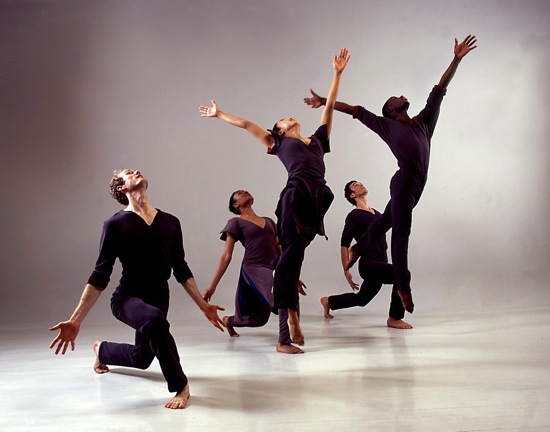
An earlier group of Limón Dance Company members performs José Limón’s Psalm. Photo: Beatriz Schiller
It was several days after I saw the Limón Dance Company at the Joyce Theater that I suddenly discerned subtle connections among the four works on the program that artistic director Carla Maxwell put together for the company’s 68th anniversary—two by company founder José Limón (1908-1972) and two new works, one by Dianne McIntyre and one by Sean Curran.
Limón’s Mazurkas and Psalm reveal two strains of his choreography—the dramatic and the choric. He made Mazurkas in 1958 as a corollary to his Missa Brevis of the same year. The latter magisterial work was prompted by his company’s visit to the destroyed Polish cities of World War II. If in Missa Brevis,he celebrated the Polish people’s heroic, undying spirit by building cathedrals of dancing around the particulars of the Mass. Mazurkas, set to Chopin piano music, paints the joy of a community gathered to celebrate some unspecified occasion—perhaps (all too appropriately this year) the coming of Spring. It’s full of leaps and bounds, the men displaying their strength, the women flipping their skirts as they twist and turn. The formations that in Missa Brevis suggested shifting walls and choral prayers here become the festive circles and lines of a folk dance.
Psalm, made nine years later, re-stated a theme that pervaded most of the dances in which Limón himself appeared. But this time, his protagonist wasn’t Othello, Judas, Julian The Apostate, Eugene O’Neill’s Emperor Jones, or any other famous figure from history or literature struggling with a moral dilemma. The solo figure in Psalm, called The Just Man, embodies the thirty-six just men of Hebrew tradition, who unknowingly bear and help contain the evils of the world. In 1967, Limón may have already been looking ahead to his end, and his words, printed in the Joyce program, speak of the “heroic power of the human spirit, triumphant over death itself.” At Psalm’s premiere, Louis Falco danced the role of the burden bearer amid the interweaving throngs of people moving in synchrony.
The very diverse choreographers of the two new works echo themes and elements of the Limón works, as their titles suggest. McIntyre’s solo for Roxane D’Orleans Juste is named She Who Carries the Sky and the full-company piece by Sean Curran is called Nocturnes for Ancestors.
McIntyre has cast D’Orleans Juste, who is celebrating her thirtieth anniversary with the company, as a hero, who, like The Just Man of Psalm, is unaware that she is one of those people strong enough to bear any burden and have been chosen by God to carry part of the sky on their heads (a program quote from Edwige Danticat’s Breath, Eyes, Memory makes this statement).
D’Orleans Juste—eloquent at conveying nuances both choreographic and emotional—appears as a powerful figure, a shaman maybe. Standing in a pool of light (lighting by Brandon Stirling Baker), she seems to stir the air, to conjure things from the earth. Once, twice, she staggers backward, as if her exertions have stirred up a bee hive.
Aware of everything around her, D’Orleans Juste bows to the four corners of the stage and often peruses the sky, as if anticipating a storm. She performs the familiar gestures of covering her eyes, her ears, her mouth, except that she pries that mouth open wide to let who knows what escape. She holds up a scarf as a kind of talisman or wraps it around herself.
The sounds of a rainstorm interrupts music by Jon Hassel and by Farafina and R. Carlos Nakari, then fades into silence. Did she cause that?
In this portrait (a trifle drawn out, but vivid), McIntyre capitalizes on D’Orleans Juste’s gift for tempering small explosions of movement and sharp little gestures with bigger, more melting steps and space-covering runs. If you’re carrying the sky, you’d better be adaptable. Sheer muscle power won’t cut it.
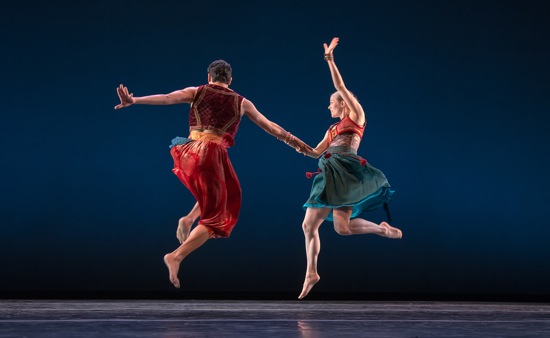
Daniel Fetecua Soto and Logan Frances Kruger in Sean Curran’s Nocturnes for Ancestors. Photo Joseph Schembri
Sean Curran’s “ancestors” are not the Judeo-Christian ones that attracted Limón, nor are they exclusively Curran’s own Irish forbears. As in some of the works he makes for his own company, angled hands and elbows and poses that evoke Indian dance mingle with hearty footwork about which I scribbled “Balkan” at some point. Rolling on the floor is included along with springy steps. The dancers wear fancy, gypsy-bright costumes by Amanda Shafran, and the music—commissioned from Lucia Caruso and Pedro H. da Silva—becomes wonderfully raucous at times, sweet as a love song at others. This is a festival for sure, but a more bumptious one than Limón’s nostalgic fete for an idyllic Polish village.
I found the opening slightly off-putting; the dancers, spaced out and facing us, going through their precise gestures in unison, might be about to open a Broadway show. But after that, the piece takes off. Like Limón, Curran plays all manner of skillful games with circles and lines that cross, dissolve, and re-form. He even channels a favorite traveling step of Limón’s: the dancer skims sideways on tiptoe with bent knees. Counterpoint is a friend of his. And in the spirited comings and goings, he points up the dancers in brief duets, trios, quartets, and more.
The dancers are wonderful. They open the evening with Mazurkas, and in their white clothes with small touches of color, they look like Sunday-best, real people, who just happen to know all these energetic, playful steps and to enjoy doing them. An extra pleasure: Vanessa Perez played the Chopin piano works live. The cast I saw (Elise Drew Leon, Daniel Fetecua Solo, Durrell R. Comedy, Kathryn Alter, Logan France Kruger, Brenna Monroe-Cook, and Francisco Ruvalcaba) gave fine performances in this luminous work. As did Kristen Foote, Ross Katen, Dante Puleio, Aaron Selissen, Raphaël Boumaïla and D’Orleans Juste, who joined them in the full-company pieces. Boumaïla was eloquent as the Just Man in Psalm.
For years now, some people have dismissed Limón’s work as passé. Granted he could be ponderous or sanctimonious on occasion, and, unfashionably, he wore his heart on his sleeve in the years when postmodernism was on the ascendant. But his gifts were very great and his themes timeless. So the dissent must have to do with style, and perhaps he worked too close to our own time for us to see his work in perspective. After all, dancegoers don’t generally say of Swan Lake “that is so old-fashioned.” (True, 19th-century ballets get their updates, but still. . . .)
Coincidentally, the week following the Limon Dance Company’s season, Miki Orihara debuted Kyōmei—Resonance at the start of the annual LaMama Moves Dance Festival that runs through May 24 in LaMama’s three performance spaces. On her solo program in the Ellen Stewart Theater (May 8 through 11), Orihara dances a work by Martha Graham and one by José Limón, a 1978 vignette by Martha Clarke, a new solo she choreographed herself, and a premiere by the young choreographer Adam Barruch. Her program note explains her interest in “continuity and lineage,” and in the course of it she remarks that “A ‘New Thing’ is not necessarily new the next day, and an ‘Old Thing’ is not necessarily old, even a half century later!”
A member of the Martha Graham Company since the 1980s, Orihara has given some of the best performances I’ve seen in roles that Graham created for herself. She enters the character, the movement, and the moment in time so completely and without artifice that she seems to be creating and embodying something, not just representing it.
Kyōmei—Resonance is an elegantly arranged program. Orihara takes no bows until the end; she hurries away in the blackout after each piece. Three times composer-pianist Senri Oe fills the brief span of time when she’s changing costumes to entertain us with one of the interestingly varied pieces that he terms “Music Reflections.” The first is spare and occupies the upper reaches of the keyboard, the second, deeper, fuller; and more rhythmically vigorous, suggests a dance tune; the third hints at piano jazz in a cocktail lounge. (I like it that Oe plays suited up but barefoot.)
Orihara’s choreographic choices reveal how finely she can accommodate herself to very different styles. In Graham’s Satyric Festival Song, she’s drolly antic. Actually, this isn’t actually the work that Graham created and performed in 1932; it’s a simulacrum devised in 1994 by Diane Gray and the Graham company’s current artistic director, Janet Eilber. The impish gestures and stances that Orihara unleashes were drawn from still photos of Graham, joined in a coherent sequence, and set to perky new music for solo flute by Fernando Palacios (Daniel James plays the flute, and the dancer includes him in her inquisitive gaze). You can glimpse Graham in her late thirties in the way that Orihara cocks her hips to press against the long, narrow skirt of a dress banded in green, black, and gold or flips her long black hair into the air.
When she reappears for Maenad, she’s costumed in a short, filmy red tunic over a flesh-colored leotard (I found the costume distracting: too short, too skimpy). This luscious solo is one of those that Limón choreographed in 1971 for the women in his company and grouped together as Dances for Isadora (Five Evocations of Isadora Duncan). Now Orihara is a wild thing, rushing about, rolling on the floor. She is not quite as earthy as a Limón dancer would be, but she captures the joy in suspending a movement until gravity lures her out of it. Mark Stuparevic played the accompanying Chopin piano music.
For Clarke’s macabre Nocturne, set to recordings (by pianist Walter Gieseking) of Mendelssohn pieces, Orihara appears in sepulchral light, wearing a long white tutu. She’s naked from the waist up and shields her breasts with a crooked arm; translucent veiling is tied over her head and face, making her look like a discarded rag doll. This is indeed a dying swan, an aging ballerina perhaps—making wan gestures, drooping, recalling grace. She remembers how to cross her wrists and flap her hands like wings, but not much else. In the end, fallen to the floor, she unwinds the red ribbon that secures her veil and makes herself and us believe it’s a cane, frail though it is. Planting it, step by step, she hobbles away into darkness.
Orihara’s own Prologue contains very little dancing, but speaks eloquently of—perhaps— loss and not giving in to grief. A tall narrow screen holds a video by Tobin Del Cuore that shows her sitting erect and motionless on a wooden chair. Three other chairs are scattered around the space. She looks about her, leans her cheek down as if to place in on the seat of one chair but doesn’t actually touch it; she starts to sit on another, but straightens up as if burned just by proximity. Her film image stands and leaves the frame, while she sits on an identical chair beside the screen, her clenched hands on her lap. The music that starts up quietly is a recording by Janis Ian of “I Hear You Sing Again,” a song Ian wrote with Woody Guthrie (music by Mica Nozawa is also heard).
All that Orihara does now is very slowly unclench her fists and spread her fingers out against her skirt; her actions, seen in close-up, appear on the screen. She doesn’t look at her hands, only gazes straight ahead into some infinitely bleak memory or thought. And then, very slowly, she folds her hands back into fists, and the lights go out.
Oe composed the score for Barruch’s Memory Current, and he begins playing it on the piano in the dark, while Orihara appears in a pool of light at some distance from him (Clifton Taylor lit both this and Prologue). Now she’s wearing simple, lightweight gray pants and a matching long-sleeved top. Having passed through debility and minimally revealed despair, she returns to lyricism, but not exactly to joy. She seems to be reliving private moments and dilemmas, although not in any literal way. A marvel at creating nuances within movements, Orihara goes from big, swooping steps to ones that loosen and wilt. She performs Barruch’s sensitive, well-made solo with utter simplicity and honesty. She can stand completely still, her arms at her sides, her face calm, and make you understand that tides of thought are ebbing and flowing through her.
Old and new. Memories and plans for tomorrow. Tradition and innovation. The second depends on the first; the ghost of the first glows and sparks within the second.

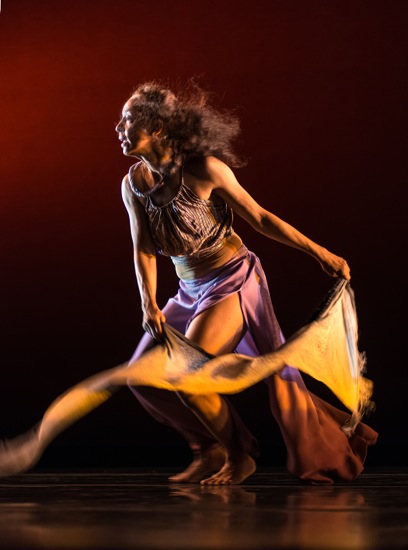
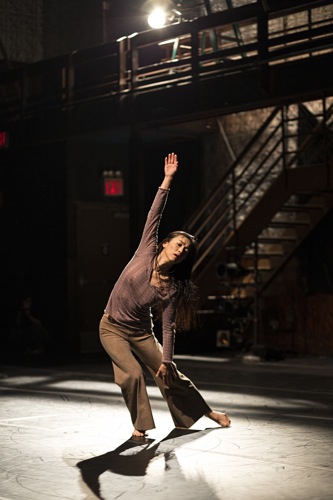
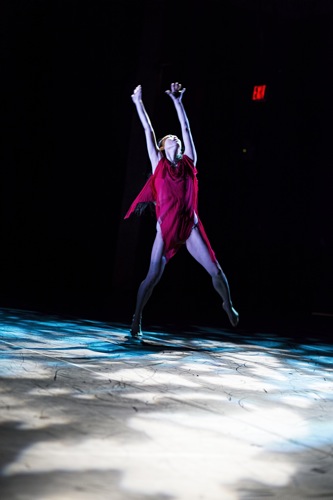
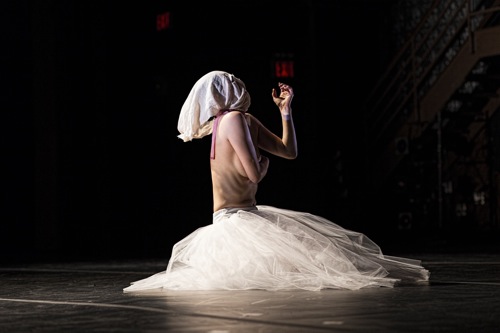
i’m fascinated to read about the Limon company. I wonder about when an artist gets outdated and how their work can come back and be reconsidered at a later time. – when I last saw the company it was beautiful – not cutting edge but it still inspired me. I have read other dismissive criticisms and worry about losing this work – also works by Graham, Humphrey, Sokolow. It has so much to give and inspire us still and I’m grateful to Carla Maxwell for keeping Limon alive and to you Deborah for your keeping it alive and in our focus through your attention and writing about it
I appreciate your support and appreciation of this wonderful company. I have valued their presence in our dance community for many years.
Miki was a wonder and many images from the evening have stayed with me. Thank you for creating a beautifully written account of a magical evening of dance.
Some years ago I took a friend to see the Limon Company in NY, at the Joyce. My friend had never been to a modern dance performance before and was very concerned that she would not understand it. I said, knowing the emotional impact Limon’s work can have, you don’t have to understand it, you just need to experience it. I forget frankly what was on the program, one of the “Mexican” pieces if you will, but my friend was completely absorbed. The work is honest, it comes from the heart as well as the head, and that is bound to move an audience of any generation. And that’s why a committed performance of Swan Lake will “speak” to today’s audiences, or of Graham’s Cave of the Heart, which I think I saw Orihara do here in Portland some years ago, is always and ever up to date. Thanks Deborah, for your contribution to that timelessness.
It seems to me that our perceptions of work continues to shift the further we get from its beginnings. What was on the leading edge of innovation looks thoroughly mainstream after awhile, and then becomes slightly old fashioned or dated. If we (and the work) stick around long enough, we get to the point where it’s become a part of our heritage, and we consider it as historic repertory.
The trick is keeping it around during the dangerous time when it’s out of fashion.